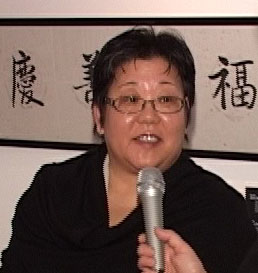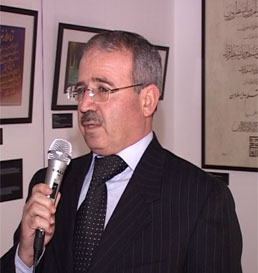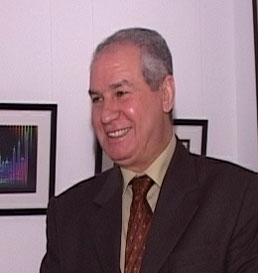Coverage of the Opening Ceremony of the Contemporary Museum of Calligraphy
Welcoming address from Andrei Busygin, Deputy Minister of Culture of the Russian Federation
“Dmitry Medvedev, President of Russia, has recommended to abstain from any entertainment today. He is absolutely right, I guess. Though Russia is a secular society, we shall pay tribute to our spiritual leader and well-known political figure His Holiness Alexis II Patriarch of Moscow and All Russia. I for one am sure that His Holiness would be happy to be present at our today’s event, because a calligraphy museum is a major cultural and, I should say, spiritual event in our lives. The museum is unique indeed and the Ministry of Culture would like to thank those people who decided to open such a museum. I would like to sincerely thank all those who put this beautiful idea into life, who established relations with countries and artists working in those countries, who invested money… all without any government involvement or support. What we see now is the rebirth of a good tradition when businesspersons take part in the cultural life of the country. Such traditions flourished in the 19th century, but unfortunately were cut in 1900-s.
I had a pleasure to see the exposition that is deeply spiritual and at the same time very timely, because in our digital era machines deform the scripts, they cannot convey the “soul” of what is written by hand. The European alphabet – the Roman alphabet – only has 26 letters, but these letters describe everything: tears and laughter, all emotions a human being may feel. Cartoons come to my mind. As a digitally produced cartoon cannot shine with all the colors, so cannot the machine fonts convey such emotions that only a human being can feel. It is very good that your museum features not only calligraphy works, but also some comments of the masters that complement the whole exposition.
I would like to greet all of you and to deliver the warm words of Aleksandr Avdeyev, the Minister of Culture of the Russian Federation whose busy schedule prevented him from being here tonight. Nevertheless, I can assure you that the Ministry of Culture will undoubtedly cooperate with those who put their hearts and souls in this exposition.
Attending representatives of foreign states shared their feelings about the Mystery of the World Calligraphy exposition
Nyamaa Chimeg, the Second Secretary of the Embassy of the Republic of Mongolia in Russia:
 Nyamaa Chimeg
Nyamaa Chimeg“First of all, I would like to thank the organizers who invited me to this grand ceremony. Frankly speaking, I haven’t been to such events for a long time and I am amazed at all I have seen here – it is beautiful. All these pictures, sketches, and images are the products of definite nations, their traditions and culture. That is why all these calligraphy works bear the national peculiarities. I’ve just spoken to Mr. Mergen (Khasbaatar Mergen, the First Secretary of the Embassy of the Republic of Mongolia in Russia) about Mongolian calligraphy; how we write letters from top to bottom. These days calligraphy in Mongolia is gaining popularity among the young people. I would like to comment on the word “serkh” (wind) written on one of the works. See how the master showed the wind in this word. Though it is a text, you get the impression that the wind is really blowing. In this work here, you can see the word “sky”, but you can also imagine this combination of letters as the sun, atmosphere or the universe. Calligraphy is an art that bears not only beautiful words and handwriting, but also depicts the world around us. Let me one more time thank you for the opportunity to enjoy your neat museum, and I hope for fruitful cooperation.”
Hasan Al-Dabbas, Adviser on Cultural Affairs of the Embassy of the Hashemite Kingdom of Jordan in the Russian Federation:
 Hasan Al-Dabbas
Hasan Al-Dabbas“I’ve seen many famous and beautiful pictures in this amazing art gallery. In Jordan, calligraphy has very deep roots. In their works, calligraphers reflect our world, Islamic outlook. Arabic calligraphy is one of the perfect arts of the contemporary world; this art counts hundreds, even thousands of years. I would like to thank the organizing committee and the head of the project for the opportunity to be here tonight. Thank you very much, for you included the works of Jordan and Palestinian calligraphers in your museum. In the future, we are going to promote your project in Russia, and we are planning to invite other Muslim calligraphers who will lend their works to your museum. Besides, we can support your efforts in contacting Arabic embassies in Russia and foreign countries.
Khalid Miaree, Adviser of the Embassy of Palestine in the Russian Embassy:
 Khalid Miaree
Khalid MiareeFirst of all, thank you very much for your invitation! It is an honor to be here tonight. We highly appreciate the work of all the artists represented here, and we take it as the cultural part of life. And as far as it is the true art, these letters are the expressive means that shows what we say, how we say it and under which conditions we say it. We are happy to see here many beautiful works that give joy and happiness. So much soul was put in all these works. We are proud that the representatives from Palestine also participate in your project. And though only one Palestinian calligrapher participates in this exhibition, some of his works have enriched the museum’s permanent exposition.
Arabs and Muslims value the art of calligraphy very much. To begin with, let us take the Qur’an: there are many ways of writing this Holy Book and every master tries to render it in his own, most beautiful, way. In the whole world there are many Qur’an copies which are themselves cultural and historical monuments. They are kept both in Arab countries and in Russia and bear the millenary history of the Arab history and I think it is very important.
For the largest part ill handwriting in the world is caused by hurry.
(Lewis Carroll)



